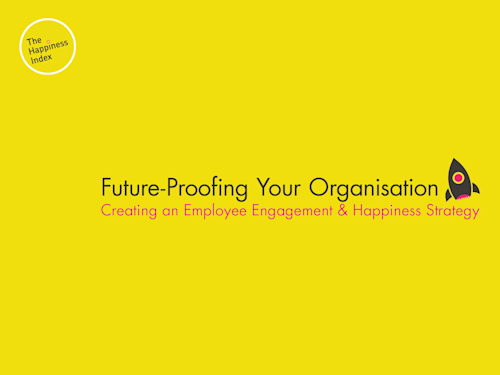
Creating an Employee Engagement AND Happiness Strategy
Employee engagement is an “issue” that every business leader must think about. No, it’s not going away. No, it isn’t just a buzzword/phrase. Yes, it will become increasingly more important… especially when you consider the continued adoption of AI and the rate of change in the world of work more generally!
Before we get into the detail on current trends, we'd recommend reading our article which defines exactly what employee engagement is and how it differs from employee happiness.
Ever since workers’ rights were legislated and you could no longer use brute force or fear to boost productivity – employee engagement has been the most important catalyst for business success.
There’s never been a point in time when a business’s people haven’t been the principal catalyst for its success:
Do you think the Eiffel Tower would look so impressive if it wasn’t for its amazing team of builders? It would still be a little prototype model gathering dust on an architect’s desk somewhere.
Do you think Henry Ford would have manufactured the Ford automobile and revolutionised modern transportation? He certainly didn’t build every car by himself…
Do you think your business will still be around in 5 years if your entire team is disengaged? Productivity and performance will suffer, and no one will want to stay or join your business. Not good!
So what trends can you focus on now to reap the benefits of employee engagement for years to come?
It seems like business leaders make headlines every day with unpopular decisions. Often the way that these are communicated are at the root of the backlash. Our co-founder, Matt Phelan, describes this as the ‘Great CEO Awakening’. He predicts that CEOs are going to need to learn to adapt and lead a new world, but they’re going to need help to do this.
Forbes reported that only 50% of employees described their CEO as empathetic while 96% believed it was an important factor in employee retention.
A Gallup study in the US showed that only 23% of employees trusted their leadership teams.
An article in Harvard Business Review reported that the least effective leaders had three to four times as many unengaged employees.
Bring emotions back into the workplace - understanding how your people think and feel whilst at work can help you create an empathetic work environment.
Dive deeper into the safety of your workplace - getting to the root of how safe your people feel and how much they trust your team will allow you to take actions to solve problems.
Treat your people like human beings - your team are your greatest asset, aligning your organisation’s vision to their values and helping them to understand how they are impacting your organisation will support your employee engagement.
AI might seem like it’s becoming a bit of a buzzword at the moment, but our CTO, Matt Stannard, believes that this isn’t a flash in the pan trend, but something that is here to stay. While AI can be a major force for good in organisations - cutting down time on busy work and reducing workload while encouraging creativity - however there are potential pitfalls, so you need to be clear on what you’re buying into.
Forbes reported that 80% of HR teams lack the digital tools they need to do a good job.
Fortune magazine ran an article with a headline revealing that Data and AI are the highest priority tech investments, with 79% of CHROs planning to invest in these areas.
Mercer’s Global Talent Trend report found that 60% of companies plan to boost their use of automation.
Take action with a plan - start by auditing internal resource and talents and getting a good understanding of available budgets, this will help you to know what is realistic when it comes to bringing AI into your HR processes.
Survey your team - understand what your people want and need when it comes to AI, this will help you prioritise and get buy in from your team.
Increase your knowledge of the topic - upskill yourself using our Employee Happiness & AI eBook which looks into AI trends in HR and helps to demystify the topic.
In our study of millions of human beings in hundreds of organisations, we found that personal growth is consistently a neuroscience theme that organisations are underperforming in. Our co-founder and Head of Happiness Innovation, Tony Latter, predicts that this is going to be a major differentiator for organisations moving forward. Those who are able to succeed here will be able to leverage this for increased employee engagement.
Opportunities for growth is the joint lowest scoring theme within our platform, and it has the highest standard deviation, telling us that showing people have opposing views on the topic.
Only 34% of employees are very satisfied with their job specific training.
LinkedIn Learning reported that 68% of employees prefer to learn on the job.
Treat your people as individuals - everyone has unique learning needs and so a one-size-fits-all programme is unlikely to work, especially if you have a diverse, inclusive culture.
Make training accessible to everyone - this means keeping all available training in one easy-to-find place to empower your people to find the training they need, but also making sure it’s accessible to people with different needs.
Dedicate time to delivery - one of the most common things we see when working with organisations is that employees don’t find they have time to complete training. Budgeting resource for both delivery and attendance is key!
Cost of living has become something of a meme at this stage, but the truth is that we’re living in difficult economic times and everyone has their bottom line on their minds. Organisations are being forced to do more with less, but individuals also need to pay their bills. Our People Partner, Laura Page, predicts that pay transparency is going to be a key theme when it comes to improving employee engagement moving forwards.
A survey by Monster found that 61% of workers say that salary is their top consideration when looking for a new job.
98% believe that pay transparency is important and 53% wouldn’t apply for a job without a doesn’t include a salary range according to the same survey.
The survey also found that more than half of workers believe that salary transparency is key to improving salary equity.
Review your process - our own HR team has just completed this vital piece of work; it’s so important that you and your team have clarity on when pay reviews can be expected and what they will look like for everyone so benchmarking internal salary ranges is also helpful.
Share don’t scare - coined by our own finance whiz, Noelle Kelly, this means that it’s important to share information transparently on the organisation’s financial situation. This will give everyone clarity and help people understand your limitations.
Think about your recognition programme holistically - thinking about your whole benefits package and also how you acknowledge your team through non-monetary avenues can have a big impact on their patience when it comes to salary expectations.
While we don’t like to bring up the pandemic too often, the truth is that it fundamentally shifted the working world, and it looks like a lot of the changes it set into motion are continuing apace. One of these is the shift in the relationship between individuals and the organisations they work for. Customer success expert, Ines Viana-Baptista, predicts that as the relationship becomes more two-way, organisations will need to shift their offering to keep up with employee demands.
PersonelToday reported that 1 in 5 workers are planning to leave their organisation this year, while a further 12% expect to leave within 2 years.
A study by the American Psychological Association showed that only 17% of employees would recommend their friends and family join their workplace if they felt the organisation wasn’t committed to their wellbeing.
A Glassdoor survey found that 87% of workers believe that their employees should be helping them prioritise work-life balance.
Focus on an inclusive culture - for many organisations this means including flexible working, a hybrid office structure, and a human-first approach to policies. This will mean that everyone can engage with work in the way that allows them to thrive.
Don’t prioritise retention above all else - sometimes people leave and that’s important for their development and presents an opportunity for your organisation. The fact of the matter is that people don’t have jobs for life anymore, and ignoring this reality doesn’t benefit anyone.
Broaden the scope of your HR programmes - think about trending topics like wellbeing, equality and ESG. These are important to your people and they expect organisations to support their priorities.
The number of organisations investing in ESG is increasing globally, and our Head of Product predicts that as individuals get serious about the environment and align their working world to their values, this is going to have a big impact on engagement. Understanding your team’s meaning and purpose and ensuring you’re meeting their needs here will be a major factor in engagement programmes moving forward, and if you start now, you could be at the forefront of this trend.
A study by PWC found that over 75% of respondents would stop buying from companies that treat the environment, employees, or their community poorly.
Only 50% of employees believe their company performs well against environmental metrics according to NAVEX Global.
Bloomberg Intelligence estimates that ESG-related investments will surpass $50 trillion by 2025.
Map Priorities - understanding what your people want you to prioritise will help you gain maximum ROI when it comes to investing in your ESG programme as it will ensure it appeals to your team.
Look at ESG holistically - thinking about environmental, social and governance aspects can really bring your programme to life and you may well find you’re already doing more than you think, just spread between different departments.
Prioritise communication - working with customers we often find that employees aren’t aware of all the investments being made into ESG by their organisations. Nailing your communication strategy can be as important as doing the work in the first place.
By taking small steps to ensure your people are engaged and happy at work, you will start to build a business of the future! Your people will feel proud to work for you and will become your greatest advocates and ambassadors. They will be motivated by more than just a pay check which will help to drive your business and create a culture of trust and hard work. This translates to better productivity, higher retention rates and improved profits. It’s win-win for everyone.
Employee engagement is not a one-size-fits-all approach. Using any of these strategies in isolation will be effective but the best engagement results will be unearthed when you implement all the above strategies in tandem. If you're looking to take the next step in your journey, why not checkout our top 10 engagement software review, which explores the various different HR needs an organisation may have and the products we'd recommend.

Linked to Engagement in our neuroscience methodology... learn more
The Happiness Index helps organisations measure the key employee engagement AND happiness drivers to power their people strategy.
Our unique platform offers the products, insights and tools to shine a light on your cultural health and empower management to drive thriving cultures.
Our neuroscience-based pre-built surveys measure the full employee experience - from onboarding to exit to empower and enable organisations to understand their people and create data-led action plans.
